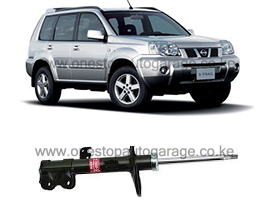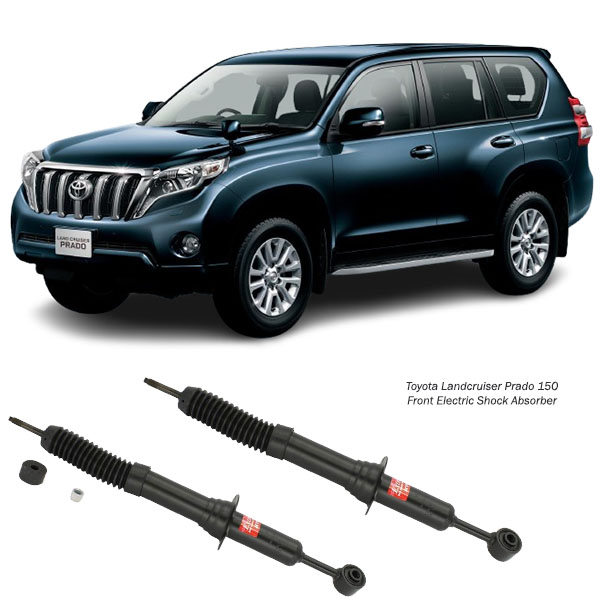-11%
Get Toyota Landcruiser Prado 150 Series Front Electric Shock Absorber Assy 741071 in Kenya
The Front Electric Shock Absorber Assembly is a crucial component of modern vehicle suspension systems, combining electronic control technology with traditional shock-absorbing mechanisms to enhance ride comfort, stability, and handling. Unlike conventional shock absorbers, electric shock absorbers adjust damping force dynamically using an electronic control unit (ECU), ensuring optimal performance across different road conditions.
This guide provides an in-depth understanding of the function, components, working mechanism, failure symptoms, replacement process, and maintenance tips for Front Electric Shock Absorber Assemblies.
1️⃣ What is a Front Electric Shock Absorber Assembly?
A front electric shock absorber is an electronically controlled damper that regulates suspension movement in real time. Installed on the front wheels, it ensures smoother rides by adjusting shock absorption based on speed, road conditions, and driving mode.
✔️ Adapts to road conditions instantly
✔️ Enhances comfort and handling
✔️ Reduces vibrations and body roll
✔️ Works with other electronic suspension components
Many modern vehicles, including luxury cars, sports cars, and SUVs, use electric shock absorbers as part of an adaptive or active suspension system.
2️⃣ Components of a Front Electric Shock Absorber Assembly
A front electric shock absorber consists of several key components that work together to provide dynamic damping control.
Main Components:
🔹 Shock Absorber Cylinder – Contains hydraulic fluid and damping components.
🔹 Piston & Rod – Moves inside the cylinder, controlling fluid flow and damping force.
🔹 Electromagnetic Valves – Adjust damping force based on electrical signals from the ECU.
🔹 Electronic Control Unit (ECU) – Processes data from sensors and controls the shock absorber’s response.
🔹 Wiring Harness & Connectors – Connects the shock absorber to the vehicle’s electrical system.
🔹 Bushings & Mounts – Absorb vibrations and secure the shock absorber to the chassis.
These components work together to improve ride quality, reduce impact forces, and optimize suspension performance.
3️⃣ How Does a Front Electric Shock Absorber Work?
Unlike conventional shock absorbers that rely solely on hydraulic resistance, electric shock absorbers use electromagnetic or electronically controlled valves to modify damping force dynamically.
Step-by-Step Working Mechanism:
1️⃣ Sensors Detect Road Conditions – Wheel speed sensors, accelerometers, and other data sources provide real-time input to the ECU.
2️⃣ ECU Processes Data – The suspension control module determines the optimal damping setting.
3️⃣ Electromagnetic Valves Adjust Damping – The shock absorber increases or decreases damping force based on driving conditions.
4️⃣ Instant Response – Adjustments happen in milliseconds, ensuring superior handling and comfort.
5️⃣ Integration with Drive Modes – Many vehicles allow drivers to select between Comfort, Sport, and Off-Road modes, adjusting the damping characteristics accordingly.
This real-time adaptability provides better traction, reduced body roll, and enhanced driving dynamics.
4️⃣ Signs of a Worn or Failing Front Electric Shock Absorber 🚨
A failing electric shock absorber can compromise safety, ride comfort, and vehicle handling. Look out for these warning signs:
❌ Excessive Bouncing – If the car continues to bounce after hitting a bump, the shock absorber is no longer functioning properly.
❌ Unstable Handling – Poor response in turns, excessive body roll, or difficulty controlling the vehicle.
❌ Rough & Uncomfortable Ride – A failing electric shock absorber may lose its ability to adapt, leading to a stiff or bouncy ride.
❌ Leaking Hydraulic Fluid – Visible oil leaks on the shock absorber indicate a damaged seal or piston.
❌ Warning Lights on Dashboard – Many vehicles with electronic suspension systems will trigger a Check Suspension or ABS warning light if the shock absorber malfunctions.
❌ Knocking or Clunking Sounds – Loose or worn-out components inside the shock absorber can produce noise.
❌ Inconsistent Drive Mode Performance – If the vehicle no longer adjusts suspension settings when switching between drive modes, the electric control system may have failed.
Ignoring these signs can lead to increased tire wear, reduced braking efficiency, and unsafe driving conditions.
5️⃣ Causes of Front Electric Shock Absorber Failure
Several factors can contribute to premature wear and failure of electric shock absorbers:
🔹 Normal Wear & Tear – Over time, internal seals, fluid, and electronic components degrade.
🔹 Harsh Driving Conditions – Driving on uneven roads, potholes, or off-road terrain accelerates wear.
🔹 Corrosion & Moisture Damage – Water or dirt infiltration can damage electronic components.
🔹 Electrical Failures – Wiring issues, sensor malfunctions, or ECU problems can prevent the shock absorber from functioning correctly.
🔹 Hydraulic Fluid Leaks – Loss of shock oil reduces damping efficiency.
🔹 Impact Damage – Hitting a curb or pothole at high speed can bend or damage the shock absorber.
Regular inspections and maintenance can help prevent expensive repairs and potential suspension failures.
6️⃣ How to Replace a Front Electric Shock Absorber Assembly? 🛠️
Replacing an electric shock absorber requires precision and attention to electrical components.
Tools Required 🛠️
✔️ Jack & Jack Stands
✔️ Lug Wrench
✔️ Socket & Wrench Set
✔️ Torque Wrench
✔️ Electrical Diagnostic Scanner
✔️ Hydraulic Fluid (if required)
Step-by-Step Replacement Guide:
1️⃣ Disconnect the Battery – Prevents electrical issues while working on the suspension.
2️⃣ Lift the Vehicle – Use jack stands to safely raise and support the car.
3️⃣ Remove the Wheel – Provides access to the shock absorber assembly.
4️⃣ Disconnect Electrical Connectors – Carefully remove wiring connections leading to the shock absorber.
5️⃣ Unbolt & Remove the Shock Absorber – Loosen mounting bolts and carefully take out the old assembly.
6️⃣ Install the New Shock Absorber – Secure the new assembly in place with proper torque settings.
7️⃣ Reconnect Electrical Wiring – Ensure all connections are secure and undamaged.
8️⃣ Reinstall the Wheel & Lower the Car – Tighten lug nuts to specification.
9️⃣ Calibrate the System – Use an OBD scanner or manufacturer-specific tool to recalibrate the suspension system.
🔟 Test Drive & Inspect – Verify proper operation in different driving modes.
Proper installation ensures optimal performance, stability, and longevity of the suspension system.
7️⃣ Maintenance Tips for Front Electric Shock Absorbers 🛠️
✔️ Regular Inspections – Check for leaks, corrosion, or damage every 15,000 – 20,000 miles.
✔️ Keep Electrical Components Dry – Avoid water or moisture infiltration near shock absorbers.
✔️ Avoid Harsh Road Conditions – Potholes and rough terrain can cause unnecessary wear.
✔️ Perform Diagnostic Scans – Periodically check the ECU for suspension-related error codes.
✔️ Replace in Pairs – Always replace both front shock absorbers together to ensure balanced performance.
A well-maintained electric shock absorber improves ride quality, fuel efficiency, and vehicle longevity.
Conclusion 🎯
The Front Electric Shock Absorber Assembly is a vital component that enhances ride comfort, handling, and safety using advanced electronic damping technology. Timely replacement and maintenance are essential to ensure smooth driving performance.
📌 Key Takeaways:
✔️ Adapts to road conditions in real time
✔️ Enhances comfort and vehicle stability
✔️ Failing shocks cause handling & safety issues
✔️ Professional calibration is necessary after replacement
Regular inspection and maintenance help keep your vehicle safe, stable, and responsive! 🚗⚡🔧
Follow us on Facebook for more parts.



